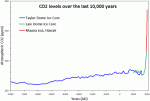Glen Contrarian
DP Veteran
- Joined
- Jun 21, 2013
- Messages
- 17,688
- Reaction score
- 8,046
- Gender
- Male
- Political Leaning
- Progressive
Notice the word "could", that does not mean will, and crop yields tend to be increasing.
But alas, I was not actually talking about crops, but all biomass, trees, shrubs, ect.
How much weight can a poplar gain in a year?
How many grow per acre?
640 acres per square mile, is many tonnes of biomass per year per square mile.
And each ton, uses up 3 tonnes of CO2.
And again, the simple fact which destroys your contention is that if the biomass were increasing enough to handle the extra CO2, then our CO2 level would stay STABLE. But it's not. Instead, it's continuing to rise at an accelerating rate. Your "extra biomass" claim isn't the panacea you seem to think.

